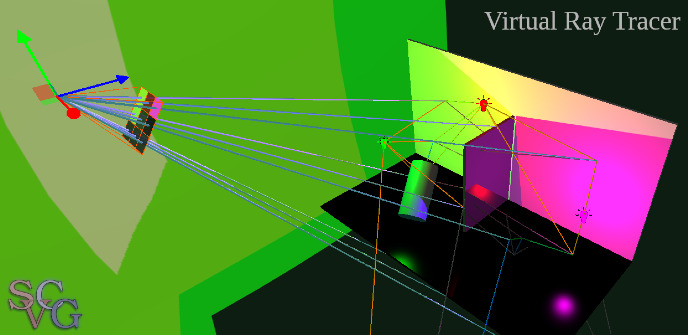Virtual Ray Tracer
Open Research objectives/practices
Our idea for Virtual Ray Tracer, an application for visualising the ray tracing process in computer graphics, was born about two years ago. Ray tracing is used in animated films, and now increasingly also in real-time applications such as computer games, to bring digital characters and scenes to life. This makes it a fundamental method that is taught in most, if not all, computer graphics courses. We set out to create an open-source tool which students of graphics, but also members of the general public, can use to learn how ray tracing works and how it leads to the high-quality images and animations we are so used to nowadays. To freely disseminate Virtual Ray Tracer, we have published a software paper on it in the education track at the Eurographics conference in 2022. The paper and the tool (including its source code under the permissive MIT licence and a Google Play app) are openly available online (see the links below).
Introduction
We have made Virtual Ray Tracer an open-source project, freely available on GitHub. The accompanying paper is freely available in the Eurographics Digital Library. This way, students of computer graphics as well as graphics enthusiasts from the general public can take full advantage of it. The tool is now actively being used in the Computer Graphics course at the University of Groningen.
Motivation
The whole Virtual Ray Tracer project was set up as an open-source initiative. Our motivation was to build an educational graphics tool that can be used not only by us in our courses and research, but also way beyond that. The open research practices used (both for the tool and the paper) have opened up many future possibilities, including for universities, teaching programmes, research groups, or even interested enthusiasts from the general public, to freely use the tool, modify it to suit their needs, or build on it further. The tool remains under active development and we stay committed to providing all future versions as open source, too.
Lessons learned
Building an advanced graphics tool from scratch is no small feat. We have thus decided to build Virtual Ray Tracer on the freely available and cross-platform game engine Unity. This meant that we could focus on the novelty of our tool, rather than on reinventing the wheel. At the same time, this led to challenges regarding keeping the tool open source. Unity offers many extensions, but only a portion of those meets the requirements of MIT licensing. This meant that some components had to be replaced by alternatives with an MIT licence or even reimplemented by ourselves. Although producing the tool would have been considerably faster had we used restrictively licensed components, we strongly believe the extra effort to keep it fully open has been worth it and will lead to many future benefits. As an example, we are now actively exploring the option to combine Virtual Ray Tracer with the RePiX VR environment for graphics (but not ray tracing) learning in virtual reality, developed at RWTH Aachen University in Germany, conveniently also in Unity.
Furthermore, having Virtual Ray Tracer freely available as a web tool and on Google Play gives us the opportunity to easily showcase it and share it with not only students, but also other interested parties. This also makes it easy to deploy demos of Virtual Ray Tracer, such as the one that will be shown at the European Researchers’ Night / Zpanned Zernike event in the Forum in Groningen in a few weeks’ time. It is very rewarding to see others use, enjoy, and learn from our tool.
URLs, references and further information
The project on GitHub (MIT licence): https://github.com/wezel/Virtual-Ray-Tracer
Freely accessible paper: https://diglib.eg.org/handle/10.2312/eged20221045
Virtual Ray Tracer started in 2021 as a BSc thesis project collaboration of Chris S. van Wezel and Willard A. Verschoore de la Houssaije under the supervision of Jiri Kosinka and Steffen Frey in the Scientific Visualization and Computer Graphics group of the Bernoulli Institute at the University of Groningen. In 2022, several other students contributed to it with various extensions (such as porting it to mobile and web and gamifying the tool). All these extensions are freely available (again under the MIT licence). These will form the basis of our next paper on Virtual Ray Tracer, which has been invited by one of the open-source journals of Elsevier due to our Eurographcs 2022 paper receiving the best educational paper award. We believe that the open-source nature of our project and the tool has contributed to this success.

